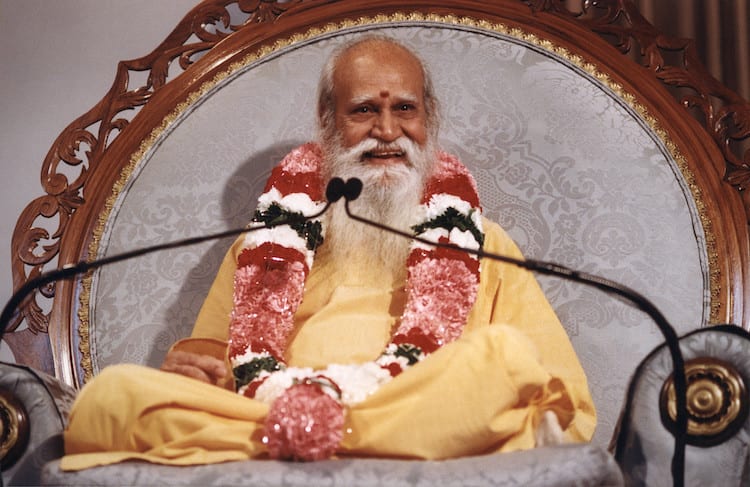Excerpt from An Evening with Swami Satchidananda
Somehow, as I was coming here to the hall, I thought: What is the easiest way to get over all the obstacles? Because we all want to grow. We all want to be nice. We all want to be wonderful people. We all want to be divine angels. That’s why if somebody says, “Oh, you’re an angel,” you’re so happy. If somebody says “devil,” you really become that devil. So that means we all want to be called as fantastic people, because that is what we are originally. In truth we are all angels, we are all divine. Haven’t we read from the scriptures that God made humans in His own image? So God has made people in His own image. Humans must be God—divine. There’s no doubt about it.
But somehow we seem to have forgotten that, and we seem to have gotten involved with some kind of lower animalistic tendencies. Some of the great men have said that even in the human form there can be many animals hidden, and consciously or unconsciously we seem to be recognizing that. Haven’t you heard people saying, looking at somebody “Oh, that man? He’s a cunning fox!” This is addressed to a human being. “Look at him! Howling like a dog.” “Him? Oh, don’t go near him. He’s a snake.” Or, “Oh, He is just a cow. He’s soft.” We use these terms. “Oh, he is a lion.” People are even proud of calling themselves “Lions” nowadays. Don’t you know that there is a group of lions? I once thought that I’d be meeting all the lions there when they invited me. But they’re all human beings.
So that means there are these tendencies hidden inside. I’m not here to tell you how we got them or when and where. That I will leave alone, or else there will be some controversial questions coming. “Oh, did we live before?” “Are we going to live after?” Incarnation, reincarnation, and so on and so forth. I will just leave it to you people to decide that. But we do seem to have all those tendencies. We seem to recognize them. Sometimes we enjoy eating, eating, and overeating. We forget why we eat. We think we are living to eat. Whereas Gandhiji said: “Isn’t it better to eat to live than live to eat?” Because we are controlled by the lower tendencies; the tongue and the eyes and the senses seem to be controlling us.
In the yogic theory, it has been recognized that most of our sensual and lower tendencies are located in the lower half of the trunk. Certainly most of you might know about the six or seven psychic centers, the chakras, or the six lotuses and the seventh, one-thousand-petalled lotus. They are psychic centers located along the spine. The lowermost one is the muladhara, at the base of the spine. Then comes the swadisthana at the sacrum, then the manipura at the navel, then the heart—anahata, and the throat, vishuddha, and the place between the eyebrows, ajna. And then the sahasrara —the crown chakra. These are nothing but psychic centers. You can’t just operate on the body and see those centers there. Sometimes they are personified as lotuses with several petals. There’s no lotus or petal growing in there, but actually they are psychic centers with different faculties. Each center controls certain tendencies of the human being. Normally it is recognized that below the anahata, or heart chakra, we have the lower tendencies. The heart and above, we have the higher tendencies.
So the divine is above and the devil below. That is the reason why it’s always better to meditate either on the heart or above the heart. Because if you direct your attention to any place, you are going to energize that place. So, by our attention, if we are going to energize the lower chakras, we may have certain problems in handling them. If we could always draw our attention upward, these problems more or less get weakened. Then they won’t dominate in our life. So it’s the easiest way to control the undesirable senses.
It’s recommended to meditate either on the heart or above. Of course, according to the different attitudes, tastes and temperaments you can visualize a light or some deities or some form which you like the most and feel that it’s presiding there. It’s only to keep your mind there. If you like some particular form or a light, whatever you like the most should be imagined there, so that you can easily keep your attention in that place. Automatically the higher potentials are developed at the cost of the lower tendencies. For example, if there is a dark room, and if you don’t want the darkness you cannot beat the darkness out. The easiest way to get rid of the darkness is to just bring a light inside. Bring in the opposite. If there is hatred, sow a little love there. Then that will slowly dispel the hatred.
According to the great sage Patanjali, who formulated the Yoga Sutras, this is called pratipaksha bhavana — thinking of the opposite. If you do not want something, don’t think of it and say, “I don’t want it, I don’t want it. I don’t want it.” Even if you say: “I don’t want it,” you are thinking of it. The more you think of it, the more it will be there. You may say “I don’t want it,” but it is still there by your very own thinking, because as you think so you become. Instead, just ignore it and bring in something that you want to develop and slowly the undesirable elements will go away.
Last night at the Ashram, I gave a simple example which I once learned from an automobile garage. My books are like that. I seldom read a book, but I read many things from the people who work in the road, in the garage and in the farm. So once I was witnessing a man who was servicing a car, greasing it. He said that he was going to take away the old grease and put in new grease. I was really curious to know how he is going to take away the old grease. Was he going to take out everything, clean the old grease and then put the new grease in? No. He didn’t do that. He filled a pressure gun with new grease and then he just squeezed it there and to my surprise the old grease was squeezed out. So the new grease took the place of the old grease. When it went in, it pushed out the old undesirable one.
Ah, that is a beautiful thing to do in our life, because we have a lot of frictions in our lives. All we have to do is put in some new grease. Squeeze a little love in. The hatred is pushed out. It’s very simple. And that is what is meant by pratipaksha bhavana. I could understand what Patanjali meant when I saw the man at the garage squeezing the old grease out. So it’s a matter of replacement. You can’t empty a place—it’s a known theory. What we call a vacuum is not really a vacuum. It’s not that there is nothing there. There’s not even a single place where you can say there’s nothing. It is always full everywhere. That’s why poornamada poornamidam. “It is always full, ever full.” You can never empty a place. But if you don’t want what is there, you just put something else in. Then it’s moved out. You can replace things but you cannot empty them.
Om Shanti, Shanti, Shanti
(From the February, 2011 IYTA Newsletter)



